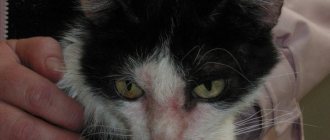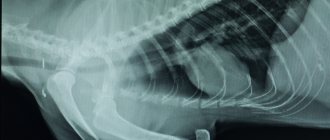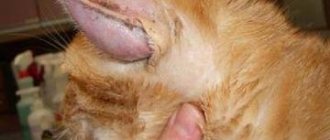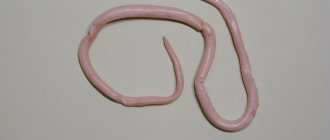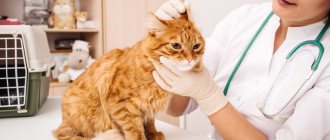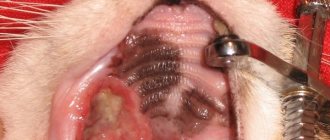4958Pavel
It is advisable for every loving owner to know the symptoms of pneumonia in cats, so that if problems with the health of their pets arise, they can promptly provide them with the necessary help. For a cat, as for a dog, pneumonia is a serious challenge. The route of infection of an animal can be different. If you miss the onset of pneumonia, there is a serious threat to the cat’s life, and even treatment does not always save the pet. At a young age and in good health, pneumonia is not common in cats. However, with age or poor environmental conditions, the lungs become very vulnerable, and pneumonia can occur one after another.
Main symptoms of lung problems
The very first symptoms are not specific and are often not noticed by cat owners:
- lethargy, apathy, inactivity;
- decreased appetite;
- sluggish response to nickname;
- The cat sleeps constantly, sometimes tries to hide in a secluded place.
These are all common signs of ill health. Within 1-3 days, the condition usually worsens and pneumonia in cats acquires bright and specific symptoms:
- a sharp rise in temperature to 40-41°C, accompanied by a hot and dry nose (atypical pneumonia can be without fever);
- noticeable and almost constant thirst;
- the fur becomes ruffled, its smoothness and shine decreases;
- feverish state with increased heart rate and respiratory rate;
- the appearance of nasal discharge (from mucous to purulent with an unpleasant odor);
- sometimes watery eyes and excessive salivation;
- cough (dry, sharply barking, turning into wet);
- on auscultation (listening to the lungs) hard, labored breathing, whistling, wheezing;
- pulmonary edema due to heart failure (a fairly rare symptom in cats, but clearly pronounced);
- sudden noticeable weight loss;
- some time after the appearance of an obvious clinical picture of pneumonia, the mucous membranes change color to bluish-pale (due to a lack of oxygen against the background of developing pulmonary failure).
It should be noted that the pathology develops very quickly, so the condition worsens literally before our eyes. A visit to the veterinarian should not be postponed under any circumstances, because... The worst consequence of pneumonia is the death of your pet!
Consequences
With timely detection and proper treatment, negative consequences can be avoided. However, in an advanced state, complications after pneumonia are quite serious :
- Pulmonary edema.
- Poisoning of the body.
- Blood poisoning.
- Respiratory failure.
- Viral infection of the respiratory system.
- Lung abscess.
- Chronical bronchitis.
- Fatal outcome, most often in sick, weak pets or kittens.
The most serious of these negative consequences occur if the pet has a weakened immune system, as well as in old and sick animals.
Non-pulmonary consequences
Possible complications not related to the lungs include encephalitis , hepatitis , and anemia . intoxication of the body may occur , due to which the load on the kidneys and liver will significantly increase, which can even cause their failure.
What does an x-ray show?
When examining any pathologies of the lower respiratory tract, radiography is considered the most informative and reliable diagnostic method. X-rays of the lungs in cats with pneumonia are always done in two projections - on the side and on the stomach.
The images are read only by a radiologist. The slightest changes in the lung tissue, fluid effusion, compaction are clearly visible, the degree of lung damage, the location of the inflammatory focus and its spread are determined.
It is recommended to carry out several x-ray procedures over time at certain intervals after the start of therapy due to the fact that the fight against pneumonia in animals can take up to one and a half months.
Prevention
Preventive measures consist of maintaining the immune system at the proper level. To do this, it is necessary to provide the cat with coziness and comfort, adequate nutrition, mainly prepared food. Regular disinsection and deworming help protect the animal from exposure to adverse factors. Prevention of infectious diseases is achieved by timely vaccination.
- Get your vaccinations up to date, especially against respiratory infections.
- Avoid hypothermia or prolonged exposure to cold or drafts.
- Strengthen your immune system by regularly taking courses of vitamin therapy.
- Provide your pet with proper and nutritious nutrition.
- Conduct a full examination of the cat for the presence of chronic diseases of internal organs.
What causes pathology and how is it classified?
Pneumonia is a pathological condition in which an animal has difficulty breathing due to pulmonary edema and narrowing of the lumen of the bronchi due to accumulated pus and fluid. Viruses and bacteria complicate the process, and the following factors can initially provoke the inflammatory process:
- complications due to any respiratory infections, bronchitis;
- chest bruises, injuries, hematomas;
- infection by lung helminths;
- decreased immunity for any reason;
- hypothermia for a long time, reaction to drafts;
- hypothermia after swimming with prolonged exposure to wet hair;
- cold drinking water or food;
- inhaling something foreign.
By the nature of the pathogen, pneumonia is provoked;
- viruses;
- bacteria;
- fungi;
- parasites;
- inhaled foreign bodies (aspiration pneumonia).
Bacterial pneumonia
It is caused by bacteria and is considered the most common form. When sputum is cultured to identify bacteria, Pasteurella spp. is most often isolated. and Bordetella bronch. In addition, cats have a chlamydia form with the specific pathogen Chlamydophila psittaci.
Parasitic (invasive) pneumonia
The name speaks for itself - when infected with worms, this particular form of pathology develops. Most often, roundworms are involved in this, less often - capillaries (Capillaria aerophila) or nematodes (Aelurostrongylus abstrusus). In newborn offspring, the pathology is incurable; infection occurs in utero.
Viral pneumonia
The most difficult form to diagnose, caused by a viral infection. It rarely occurs as an independent disease; most often it occurs as a complication against the background of other infections - for example, calicivirosis and rhinotracheitis. Roto- and coronaviruses act as pathogens. Often complicated by bacteria.
Fungal infection
It can be an independent disease, or it can occur as a complication of the main one. Most often these are cryptococcosis and aspergillosis. It is very difficult to diagnose and takes the longest to treat.
Aspiration pneumonia
Appears when a foreign object enters the respiratory tract. The most common cause of this situation is improper artificial feeding of kittens, when food particles are inhaled, as well as incorrect use of liquid forms of intranasal medications. Also, such pneumonia can develop when inhaling droplets of fine chemical liquids.
It is possible to distinguish one from the other only by blood tests with sputum cultures to isolate the pathogen. Considering the severity of the disease and the rate of progression, a blood test is indicated immediately upon contacting the clinic. It determines the presence of inflammation and its nature.
Feeding a cat when sick
Considering how much a pet weakens during illness, feeding a cat during illness also becomes of great importance:
- If the cat does not eat at all, “feed” it by injecting a glucose solution intravenously.
- When the pet's condition begins to improve, it can be given veterinary holistic treatments. We recommend special lines from Purina and Hills.
- If it is not possible to purchase holistic supplements, a weakened cat is fed boiled chicken or rabbit. Beef liver is given three times a week, and low-fat cottage cheese three times a week.
- By the end of the second week of treatment, the animal can be transferred to its usual diet.
Therapy for pneumonia
Pneumonia in cats can be treated over a long period of time and only comprehensively. It is important to accurately determine the diagnosis. Owners should know what diagnostic procedures a veterinarian performs to accurately determine pneumonia. Before deciding how to treat pneumonia, the following is carried out in a veterinary clinic:
- inspection and thermometry;
- listening to the lungs with a phonendoscope;
- auscultation (tapping the chest - convenient and informative for large cats);
- ordering a blood test;
- conducting a sputum smear;
- X-ray.
Treatment is carried out according to the following scheme (all information is given for informational purposes only and cannot be used as a direct guide to action):
Depending on the pathogen, the following are prescribed:
- antibiotics (amoxicillin, clindamycin, levofloxacin, ceftriaxone, azithromycin, gentamicin, tetracycline, etc. - approximate dosages can be found here). Ideally, if a culture is done and the sensitivity of the bacteria to the antibacterial agent is determined. However, in most cases there is simply no time for this due to the rarely worsening condition, so broad-spectrum antibiotics and sulfonamides are prescribed in therapeutic doses;
- antimycotics (antifungal agents):
| ketoconazole | 4-8 mg/kg (in special cases, the dosage can be increased to 10 mg/kg) once a day for at least 2 weeks. The daily dose can be divided into 2-3 doses, if it is convenient and there is no risk of missing a medication. |
| amphotericin B | The daily dose is 4-6 mg/kg, divided into 2-4 doses at equal intervals. It is important to monitor kidney function based on urea levels - if the level rises above 70 mmol/l, the drug is no longer given. |
| fluconazole, itraconazole | 5 mg/kg orally once daily for at least 3 weeks. |
- anthelmintics in therapeutic doses (according to individual instructions for each drug);
- antiviral drugs:
| ribaflox | Subcutaneously at a dose of 0.1 ml/kg once a day for 3-5 days. |
| forwardet | Subcutaneously or intravenously, 2.5 ml if the weight is up to 5 kg, 5 ml - if more than 5 kg. |
| maxidin 0.4 | Subcutaneously or into muscles at the rate of 0.5 ml for each animal up to 5 kg and 1 ml - from 5 to 10 kg 1-2 times a day for 5 days. Extension of the course is only agreed with the veterinarian. |
- Immunomodulators:
| roncoleukin | The average dose is 10 thousand IU/kg subcutaneously or slowly intravenously once a day. In total, the course requires 1-5 injections with an interval of 24-48 hours - regulated by a veterinarian based on the cat’s condition. |
| cycloferon | 0.4 ml/kg with a cat weighing up to 2 kg, 0.2 ml/kg – 2-5 kg, 0.15 ml/kg – 5-12 kg intramuscularly, but it can also be administered subcutaneously. |
| ribotane | 0.5-2 ml/animal intramuscularly or subcutaneously once a day for 3-5 days. |
| glycopin | ¼-1 tab. orally 1-2 times at intervals of 24 hours. An increase in temperature is possible, which does not require discontinuation of the drug. |
- Drugs that dilute sputum and facilitate its release (duration is determined individually in each specific case):
| acetylcysteine | The daily dose is 100 mg/200 ml of water per animal, divided into several doses throughout the day. Effective when there is an abundant intake of fluid into the body. |
| ambroxol | 0.5 mg/kg twice a day every 12 hours (after meals) with sufficient fluid intake into the body. |
| bromhexine | 1 mg/kg once daily. |
- In severe cases of the disease, diuretics (furosemide, veroshpiron/spironolactone) may be prescribed to relieve an attack of pulmonary edema, removing excess fluid to facilitate breathing. The dosage is always selected individually and only by a specialist, depending on the results of the examination and the state of the cardiovascular system.
- If heart failure develops against the background of oxygen starvation, the work of the heart must be supported:
| cordiamine | 0.1-0.12 ml/kg subcutaneously or into the muscle symptomatically or systemically until the condition stabilizes. |
| sulfocamphocaine | The maximum dose is up to 2 ml at a time and up to 6 ml per day by any injection method. |
- Vitamin preparations for general maintenance of the body - the emphasis is mainly on vitamins C (despite the fact that it is synthesized in cats in the body), D and A or injectable multivitamins:
| vitamin | Intramuscularly or subcutaneously 3-5 ml/10 kg 1-2 times a day for at least a week. |
- Nutritional drips may be indicated if a sick animal refuses food and water. You should not drip solutions if you suspect pulmonary edema, because the injected liquids are not absorbed by the body and provoke new swelling.
- It is better to use veterinary antipyretics, which are least likely to cause side effects:
| meloxicam | 0.1-0.2 mg/kg orally symptomatically or 0.05-0.1 ml/animal subcutaneously. |
| tolfedine 6 | 6 mg/kg (1 tablet/kg) orally for 3-5 days in the presence of high fever. |
- Bronchodilators - to dilate the bronchi, heart and brain vessels and facilitate breathing during spasms and attacks of pulmonary failure.
| aminophylline | Dosage for the active substance is 3-5 mg/kg (0.1-0.2 ml/kg) 1-2 times a day. Only intramuscularly, because subcutaneously may cause an irritant reaction. |
Diagnostics
Diagnostic methods for examining kittens for pneumonia are:
- auscultation;
- percussion;
- fluoroscopy;
- laboratory blood tests for the presence of inflammatory factors and specific immunoglobulins;
- bacteriological culture of pathological material to determine the nature of inflammation and selection of medications.
If toxocariasis is suspected, the veterinarian will additionally prescribe a stool examination for eggs of intestinal parasites.
How owners can further help
To help your pet recover, just follow these simple rules:
- Attempting self-medication is strongly discouraged.
- It is important to follow all the veterinarian’s instructions, despite the fact that treatment can take from 3 weeks to 1.5 months. Do not make any independent adjustments to the therapeutic regimen and do not interrupt courses of taking medications without instructions from a specialist.
- Provide your pet with rest, high-quality, nutritious and balanced food during treatment, and protect him from potential stress.
- If there is a decrease or absence of appetite, forced feeding of semi-liquid food, high in protein and easily digestible, is indicated.
- Do not give your cat cold water or cold food.
- Do a light tapping massage of the chest.
- During the treatment period, try not to overload the cat with games, so as not to provoke shortness of breath, increased fatigue and oxygen starvation.
Author:
Grinchuk Ekaterina Andreevna veterinarian
Treatment of pneumonia
The treatment regimen includes symptomatic therapy, as well as drugs that affect the cause of the disease. Antibiotics are prescribed regardless of the etiological factor, since the disease in most cases is complicated by a bacterial infection.
Note! All dosages are given without taking into account the individual characteristics of the animal’s body, the form and severity of pneumonia. The exact amount of medication administered and the duration of the course of treatment are determined only by a veterinarian.
Predisposing factors and causes
The cause of the disease is most often simple hypothermia, which leads to the rapid spread of infection. Poor and irregular nutrition is also considered a predisposing factor to the development of pneumonia. Premature, small kittens usually suffer from this disease. Any deviations in diet and maintenance are destructive for them.
Cats can suffer from pneumonia after hypothermia.
Often the causes of pneumonia can be viral or respiratory diseases (, etc.), vitamin deficiency, infectious diseases, and old age. Chronic or acute bronchitis, if treatment is not started in a timely manner, can also result in severe pneumonia. Even the simple entry of dust or liquid into a cat’s respiratory tract leads to the development of this dangerous disease.
Preventive measures
As you know, a disease is easier to prevent than to treat. To avoid pneumonia, you need to prevent your pet from getting hypothermic. Your cat's food and water should be at room temperature.
To strengthen the immune system, it is important to regularly give your cat vitamin and mineral supplements. It is strictly forbidden to keep the animal in drafts and cold. We also must not forget about timely vaccination. In addition, it is advisable to systematically fully examine your pet for the presence of chronic diseases.
To protect your cat from this dangerous disease, it is necessary to carry out mandatory vaccinations on time, to prevent hypothermia and to prevent the animal from being in a draft. Make sure that the cat receives a balanced and high-quality diet, with the addition of all the necessary vitamins. Regularly (at least 2 times a year) conduct a complete examination of your pet for the presence of concomitant chronic diseases.
Therapeutic measures
Diverse and multifaceted. Of course, treatment should include the complete exclusion of the factor that caused the disease itself: infection, worms, hypothermia. As a rule, specialists prescribe powerful antimicrobial drugs.
But for a reason! For the remedy to work, the doctor must take samples of pathological material from the animal and perform bacteriological culture. Based on its results, the veterinarian determines which antibiotics will work.
Their independent administration and use is strictly prohibited! Firstly, “kind-hearted” owners can simply poison the cat by feeding it antibiotics that have no effect on the pathogen. Secondly, you need to strictly adhere to the course of treatment, which is not done by everyone.
To remove the exudate that has accumulated there from the alveoli and bronchi, mucolytic and expectorant drugs are used. If swelling is observed, diuretics must be prescribed. Experts often prescribe cardiac medications, since the support of this most important organ in this case is extremely necessary.
Finally, the use of such “heavy” antimicrobial agents also involves giving funds for the development of intestinal microflora and prescribing good vitamin preparations. Complex therapy not only helps to cope with this disease in the shortest possible time, but also prevents the development of serious complications.
Here's how to treat pneumonia. We remind you once again that only an experienced veterinarian should supervise all activities!
You should keep your cat in a well-humidified, ventilated and warm room, and encourage its appetite with a selection of high-quality, healthy and tasty foods. Optimal rehabilitation for cats with pneumonia is a combination of good home care and professional veterinary care.
https://vashipitomcy.ru/publ/zdorove/bolezni/pnevmonija_u_koshek_priznaki_diagnostika_i_lechenie_vospalenija_ljogkikh/15-1-0-666
https://zoostatus.ru/lechenie/bolezni/pnevmoniya-u-koshek/

